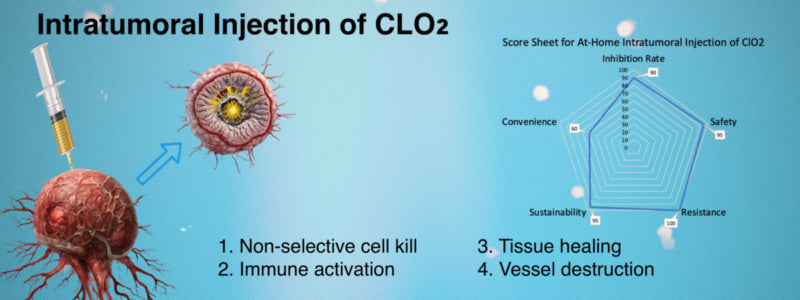
Enseñarle los conocimientos fundamentales de las inyecciones intratumorales de dióxido de cloro, lo que le permitirá utilizarlas de manera competente para abordar diversos tumores sólidos.


Active Collaboration: German and Brazilian Clinics
A German clinic and a Brazilian clinic have officially partnered with me, and both have already started offering chlorine dioxide intratumoral injection therapy as an alternative treatment for cancer patients in Europe and South America.

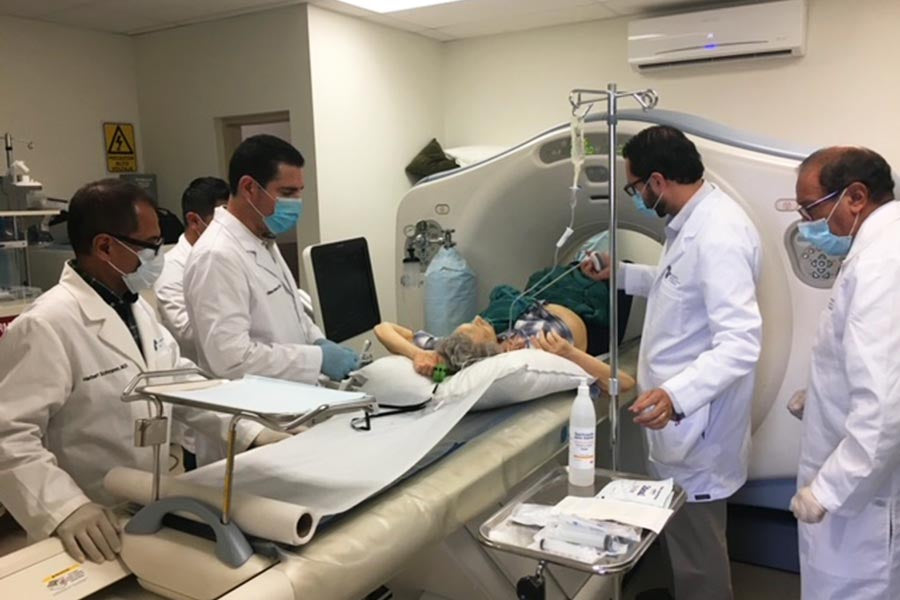
Clinic in Tijuana, Mexico Offering Intratumoral Injections
We collaborate with the ICCA clinic in Tijuana, which provides intratumoral chlorine dioxide therapy to patients worldwide. With extensive experience in intratumoral injections, it is the best partner for this therapy.

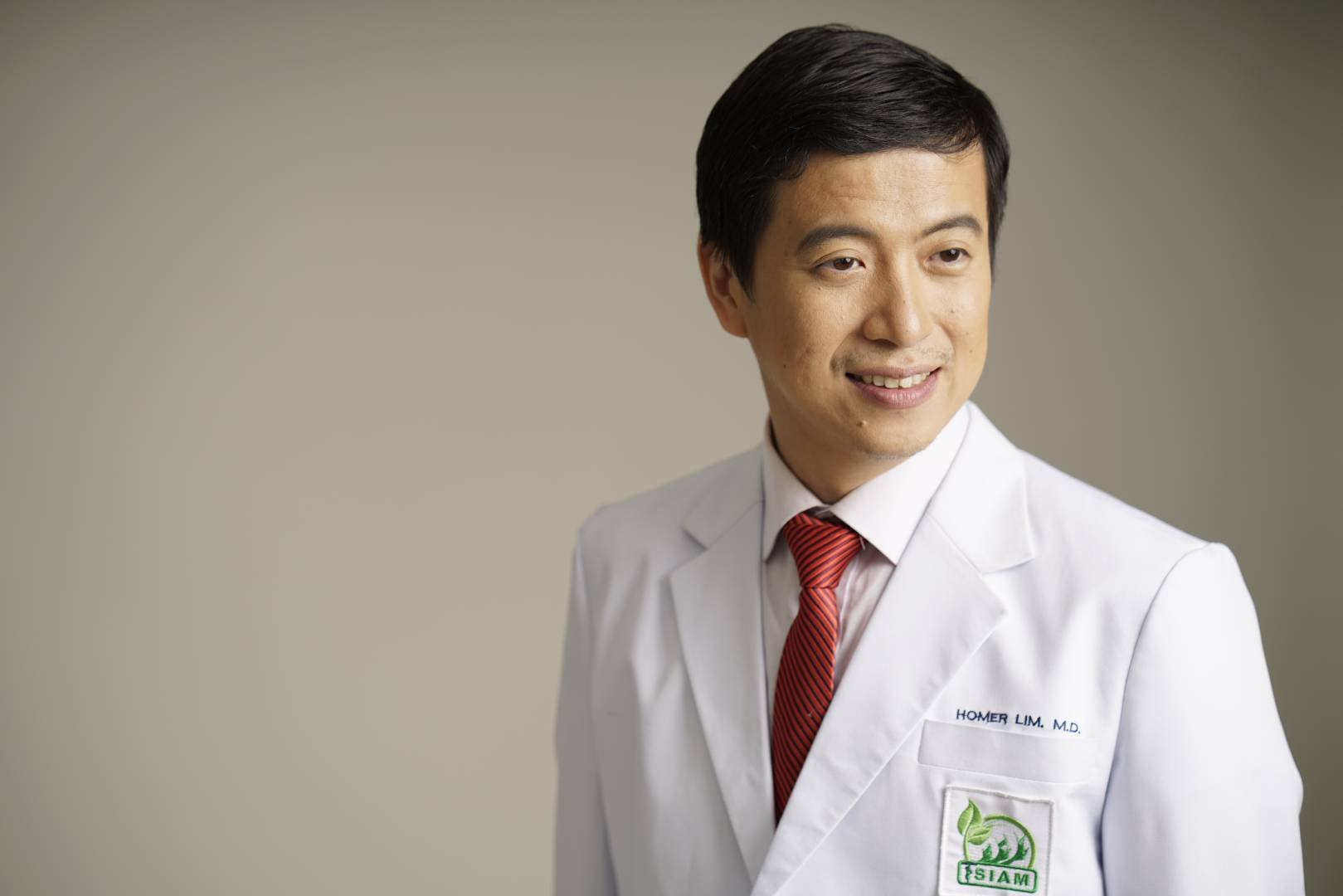
Philippine Partner Clinic: Akesis Holistic Health-Integrative Oncology
Dr. Homer Lim, Medical Director at the Philippine clinic, is very familiar with chlorine dioxide and well-versed in various CDS therapies. As an integrative oncology clinic, it can offer intratumoral chlorine dioxide treatments to cancer patients in the Philippines and throughout Asia.
Los mecanismos principales de la terapia con dióxido de cloro (CD) intratumoral para el tratamiento del cáncer
-
Las fuertes propiedades oxidativas de la CD le permiten matar células cancerosas, una ventaja significativa sobre otros fármacos inyectables (incluidos los fármacos intratumorales y los virus oncolíticos). Con la terapia intratumoral, no necesitamos preocuparnos por mantener la CD en el tumor durante períodos prolongados, lo que supone un gran desafío para muchos tratamientos existentes.
-
Altas concentraciones de CD pueden dañar directamente los vasos sanguíneos del tumor. Esto significa que no es necesario que el tejido tumoral esté completamente saturado con CD; Las células tumorales no tratadas morirán por falta de energía.
-
La EC puede desencadenar una respuesta inmune sistémica contra los tumores. En teoría, los pacientes no necesitan inyectar cada tumor. Para tumores pequeños no tratados en sitios distantes, el sistema inmunológico antitumoral sistémico de CD puede inhibir eficazmente estos pequeños tumores.
-
La CD tiene un mecanismo que ayuda en la regeneración de tejidos. Para los pacientes con cáncer avanzado, esto es crucial porque la razón por la que no pueden someterse a una cirugía es la incapacidad de curar heridas grandes después de la extirpación del tumor. Cuando los pacientes usan CD, puede ayudar a regenerar tejido y curar cualquier herida formada por ablación tumoral.
The Primary Mechanisms of Intra-Tumoral Chlorine Dioxide (CD) Therapy for Treating Cancer
-
Direct Destruction of Cancer Cells:
CD’s strong oxidative properties allow it to kill cancer cells upon, a significant advantage over other injectable drugs (including intratumoral drugs and oncolytic viruses). With intra-tumoral therapy, we don't need to worry about maintaining CD in the tumor long periods, which a big challenge for many existing treatments.
-
Destruction of Tumor Blood Vessels:
High concentrations CD can directly damage tumor blood vessels. This means the tumor tissue doesn’t need to be completely saturated with CD; untreated tumor cells will die to lack of energy.
-
Induction of Systemic Anti-Tumor Immune Response:
CD can trigger a systemic immune response against tumors. In theory, patients don’t need to inject every single tumor. For small, untreated tumors at distant sites, CD’s systemic anti-tumor immune can effectively inhibit these small tumors.
-
Promotion of Tissue Regeneration:
CD has a mechanism that aids in tissue regeneration. For patients with advanced cancer, this is crucial because the reason they can't undergo surgery is the inability to heal large wounds post-tumor removal. When patients use CD, it can help regenerate tissue and heal any wounds formed tumor ablation.
Marco de evaluación de 5 factores: inyección intratumoral de CLO2
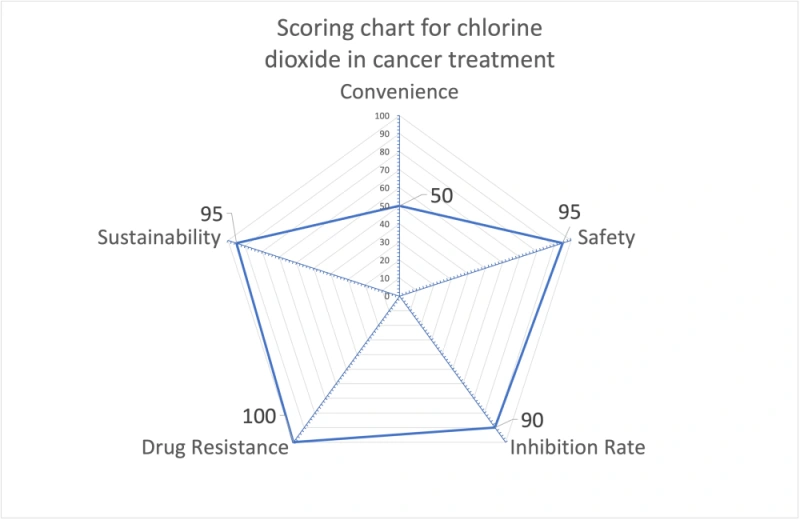
Por qué se recomienda la inyección intratumoral de dióxido de cloro
Desafíos en el tratamiento actual del cáncer
Actualmente, hay dos cuestiones predominantes en el tratamiento del cáncer. En primer lugar, el estándar global general de tratamiento del cáncer sigue siendo relativamente bajo, con tasas de mortalidad similares entre pacientes con cáncer en todo el mundo, lo que indica una variación mínima en la eficacia del tratamiento entre países. Incluso en países desarrollados como Estados Unidos, un gasto considerable no necesariamente se correlaciona con una alta eficacia del tratamiento. En segundo lugar, existe un problema frecuente de sobretratamiento, ya que los médicos a menudo pasan por alto posibles efectos secundarios futuros en la búsqueda de la erradicación del 100% de las células cancerosas, empleando numerosos métodos de tratamiento ineficaces o innecesarios.
Importancia de los factores de evaluación en el tratamiento
Al evaluar la eficacia de un enfoque de tratamiento del cáncer, es fundamental considerar cinco factores: conveniencia, seguridad, tasa de inhibición, resistencia y sostenibilidad. Destaco que estos cinco factores de evaluación se pueden deducir a través de un modelo integral de cáncer, sirviendo como base para determinar la superioridad de un método de tratamiento. El tratamiento óptimo contra el cáncer debe sobresalir en todos estos aspectos para transformar el cáncer en una enfermedad crónica y prolongar el período de supervivencia de alta calidad del paciente, que es el objetivo terapéutico último que busca la humanidad.
Ventajas de la inyección intratumoral de dióxido de cloro
Mi terapia de inyección intratumoral de dióxido de cloro sobresale en el marco de estos cinco factores de evaluación, superando cualquier tratamiento contra el cáncer actualmente aprobado.
Mecanismo y beneficios de la terapia con dióxido de cloro
Actualmente estoy investigando el uso del dióxido de cloro en el tratamiento del cáncer (específicamente inyecciones intratumorales de dióxido de cloro). El dióxido de cloro comparte propiedades similares con la herramienta del sistema inmunológico conocida como ROS y se ha demostrado que destruye las células cancerosas y promueve la reparación de tejidos. Al inyectar directamente dióxido de cloro en los tumores, puede matar selectivamente las células cancerosas sin inducir resistencia, desencadenar respuestas inmunitarias y mejorar la eficacia del tratamiento. Este enfoque innovador utiliza la capacidad del dióxido de cloro para imitar las ROS, allanando el camino para una nueva vía en el tratamiento del cáncer.
Eficacia y resultados de la terapia con dióxido de cloro intratumoral
En estudios preclínicos y ensayos seleccionados en humanos, los beneficios de la terapia con dióxido de cloro intratumoral para el tratamiento del cáncer se han hecho evidentes: 1) focalización precisa del tumor que conduce a la disolución del tumor, estimulación de la respuesta inmune y alteración de los vasos sanguíneos del tumor, lo que resulta en tasas de inhibición más altas; 2) efectos secundarios mínimos con las inyecciones intratumorales, favoreciendo la regeneración del tejido después de la disolución del tumor; 3) vías no resistentes para la disolución del tumor; 4) inyecciones sencillas con agujas estándar; 5) el único inconveniente es un inconveniente menor en comparación con las terapias orales o intravenosas, un desafío que se espera que disminuya con los avances tecnológicos.
Tumor Ablation Therapy is the Best Cancer Treatment, and Intratumoral Injection of Chlorine Dioxide is the Best Tumor Ablation Therapy
-
Tumor Ablation Therapy: The Best Cancer Treatment
Tumor ablation therapy represents a minimally invasive set of techniques aimed at specifically destroying tumor tissues. These therapies have become a cornerstone of treatment for cancers such as liver cancer, lung cancer, and kidney cancer. By precisely targeting tumors, ablation significantly reduces collateral damage, shortens recovery time, and elevates the quality of life for cancer patients.
Advantages of Common Tumor Ablation Methods
- Targeted and Precise
- Minimally Invasive
- Effective for Small, Localized, or Deep-Seated Tumors
- Reduced Systemic Side Effects
- Advanced, Noninvasive Options
- Versatility
-
Limitations of Traditional Ablation Methods:
- Limited Scope of Application: Ineffective for large, irregularly shaped tumors or those located near critical structures (e.g., major blood vessels or vital organs).
- Inflammatory Responses: Techniques like thermal ablation can trigger inflammation, swelling, and immune activation, potentially accelerating residual tumor growth or metastasis.
- Tissue Damage and Liquefactive Necrosis: Some methods may destroy surrounding tissues, causing infections or delayed healing.
- Complex Procedures: Ablation techniques can be time-consuming, making it challenging to treat patients with multiple tumors effectively.
-
Intratumoral Injection of Chlorine Dioxide: A Breakthrough in Tumor Ablation Therapy
Key Advantages of Chlorine Dioxide Therapy
- Complete and Precise Tumor Destruction
- Reduced Inflammatory Response
- Minimal Systemic Side Effects
- Repeatable and Flexible
- Simple and Cost-Effective
Chlorine dioxide therapy represents a safer, more effective, and versatile alternative to traditional tumor ablation techniques.
Para pacientes con cáncer metastásico avanzado
-

Una opción de tratamiento sostenible
Las inyecciones intratumorales de dióxido de cloro ofrecen un tratamiento conveniente y sostenible. Independientemente de la etapa de progresión del cáncer, los pacientes pueden automedicarse en casa sin restricciones. Esta terapia no es resistente, se basa en la activación de la respuesta inmune y solo requiere inyecciones en unos pocos tumores en lugar de en todos.
-

Llevando esperanza a los pacientes abandonados por los hospitales
Para los pacientes con cáncer en etapa avanzada, los hospitales a menudo abandonan el tratamiento. Sin embargo, las inyecciones intratumorales de dióxido de cloro pueden ofrecer esperanza a estos pacientes debido a sus diversos mecanismos anticancerígenos, permitiéndoles tratar eficazmente el cáncer avanzado.
-

Rentable con resultados favorables
La terapia intratumoral con dióxido de cloro tiene tres mecanismos anticancerígenos: destrucción no selectiva de células cancerosas, activación del sistema inmunológico y destrucción de los vasos sanguíneos tumorales. Para los pacientes con cáncer en etapa avanzada, cada sesión de autotratamiento en el hogar es altamente rentable y tiene efectos significativos.
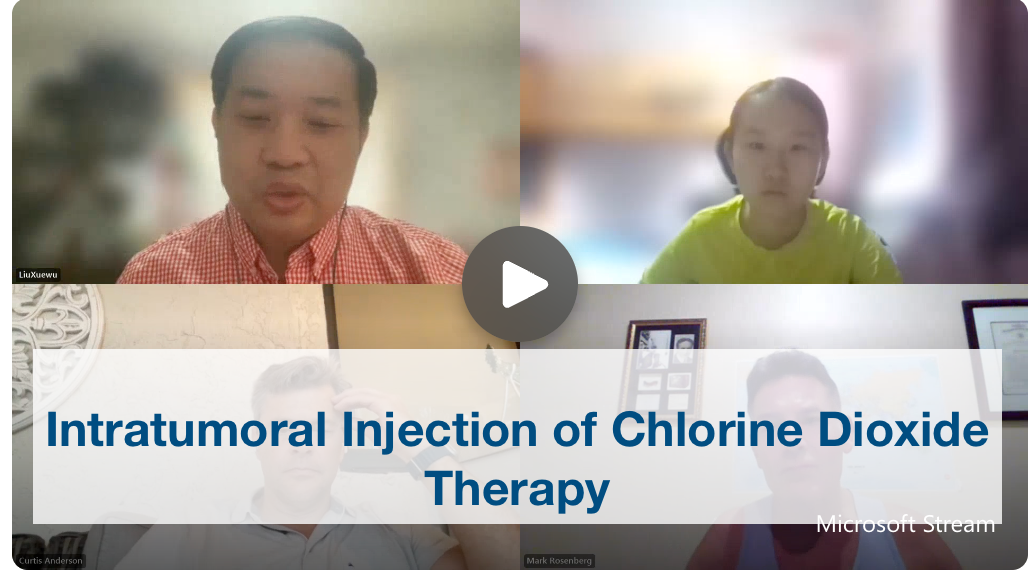
Discussion with Two American Oncologists on Intratumoral Chlorine Dioxide Therapy
On August 4th, my daughter and I held a video conference with two American oncologists to discuss intratumoral chlorine dioxide therapy. Both doctors, experts in oncology, including one specializing in interventional radiology, expressed disappointment with current advanced cancer treatments and showed significant interest in this new therapy.
Summary of Our Discussion
Background on Chlorine Dioxide
•It appears as a yellow-green gas at room temperature -Boiling point: 11 °C (52 °F)
•Solubility: In water, 3.01 g/L(3000ppm) at 25 °C and 34.5 mm Hg.
•Chlorine dioxide has gained popularity as an alternative therapy.
•Globally, medical use of chlorine dioxide is represented by MMS and CDS.
•Although few people know me, I am likely the person with the most applications for chlorine dioxide treatments for various indications globally.
Differences Between the Treatments in This Book and MMS, CDS
My Chlorine Dioxide Treatment:
•Involves directly delivering higher concentrations of chlorine dioxide to the affected area.
•Quickly treats various diseases, each with its own specific mechanism.
•All treatments in this book are supported by necessary validation data.
MMS:
•Involves significantly diluting high-concentration chlorine dioxide and ingesting it orally or via enema.
•Uses a water solution containing chlorine dioxide to treat various diseases.
CDS:
•Developed by Dr. h.c. Andreas Ludwig Kalcker as an improvement to MMS.
•Features a saturated chlorine dioxide solution (concentration around 0.3 mg/ml or 3000 ppm).
•Delivery methods mainly include diluted oral intake or intravenous injection. Sometimes other methods are used but at lower concentrations than 3000 ppm.
My Work on Chlorine Dioxide Therapy
•Discovered three mechanisms for treating diseases:
①Eliminating Abnormal Cells
②Promoting Tissue Regeneration
③Regulating Immune Response
•Detailed explanation available in the interview: Chlorine Dioxide Therapy Interview(Substack).
•Describes how chlorine dioxide effectively treats 13 diseases through these mechanisms.
The Chlorine Dioxide Miracle: Safeguarding Health with Safe and Effective Applications
Intratumoral Injection of Chlorine Dioxide Therapy
•Proposed the patent for intratumoral injection in 2014.
•Specific patent for preparation completed in 2016.
•Effective for arthritis and currently focused on cancer treatment, especially advanced cancer.
•Preclinical study report available: Preprint Link.
Personal Experience with Chlorine Dioxide Injections
•I have personally administered over 30 injections using high-concentration chlorine dioxide solution.
•Video Documentation:
•Safety Assurance:
•Based on my experience, I can assure you that chlorine dioxide injectables, when prepared more rigorously, are absolutely safe, even for healthy individuals.
Home Treatment of Advanced Breast Cancer
Current Cases:
•Three advanced breast cancer patients are currently under my guidance.
Treatment Method:
•High-concentration chlorine dioxide injections administered at home.
Current results:
- One injection dose under 10% of the tumor volume led to a 70% reduction in tumors over two months.
- Three patients with advanced breast cancer, each about three large tumors (over 4 cm in diameter), self-treated with 1-3 injections per tumor. Following the injections, they experienced pain but no other side effects.
My Book Introduces a Five-Factor Framework for Assessing Cancer Therapies
Using a five-factor framework:
•Inhibition Rate
•Side Effects
•Drug Resistance
•Sustainability
•Convenience
BOOK:《Confronting the Cancer Care Plight: Using First Principles to Navigate Your Cancer Journey》
The Primary Mechanisms of Intra-Tumoral Chlorine Dioxide (CD) Therapy for Treating Cancer
1.Direct Destruction of Cancer Cells:
–Strong oxidative properties allow chlorine dioxide to kill cancer cells upon contact.
–No need to maintain prolonged presence in the tumor, unlike many existing treatments.
2.Destruction of Tumor Blood Vessels:
–High-concentration chlorine dioxide can damage tumor blood vessels.
–Leads to untreated tumor cells dying due to lack of energy.
3.Induction of Systemic Anti-Tumor Immune Response:
–Triggers a systemic immune response against tumors.
–Effectively inhibits small, untreated tumors at distant sites.
4.Promotion of Tissue Regeneration:
–Supports tissue regeneration, aiding in healing post-tumor removal.
–Crucial for patients with advanced cancer who cannot undergo surgery due to difficulty in healing large wounds.
Comparative Advantages Over Traditional Ablation Methods
1. Convenience
Chlorine dioxide injections take only 10 seconds.
Enables at-home treatment with high convenience.
2. Higher Inhibition Rate
Directly kills cancer cells.
Destroys tumor blood vessels.
Triggers immune response.
3. Greater Sustainability
No limitation on tumor size.
Fast injection speed and low precision requirements mean almost no restriction on the number of tumors.
4. Lower Side Effects
Apart from pain, which can be managed with anesthetics and lasts about 24 hours, there are no other side effects.
Have you ever injected any tumors trans arterially? -The Interventional Radiologist's Professional Concerns
My response is that I have not performed transarterial tumor injections. However, I have considered it. Transarterial tumor injection would be very suitable for chlorine dioxide because it can effectively leverage the mechanism of tumor blood vessel destruction. Chlorine dioxide would immediately react with tumor arteries and the cells they supply, eliminating concerns about the retention time of chlorine dioxide within the tumor or its permeation into normal tissues. Therefore, if conditions permit, transarterial intratumoral injection of chlorine dioxide could be an ideal method in the future.
My Proposed Future Collaboration:
Promote Chlorine Dioxide Intratumoral Injection Therapy for Self-Treatment of Superficial Late-Stage Cancers:
For example, late-stage breast cancer. Self-treatment by patients is legal in any country and is their right. My future partners and I will offer courses and consultation services.
Currently, I offer courses and consultation services for late-stage breast cancer patients, charging each patient a $200 monthly subscription fee.
Collaborate with Interested Clinics:
I will provide the technology for free. Partner clinics can offer these treatments to various late-stage patients as an alternative therapy. All participating parties will share the profits.
I believe this can be tested in the United States and can quickly move forward in Mexico for collaboration.
Long-Term Goal: FDA Approval and Legal Sales in the United States:
Eventually, I aim to get this therapy approved by the FDA and legally sold in the United States and hope to collaborate on the new drug approval process.
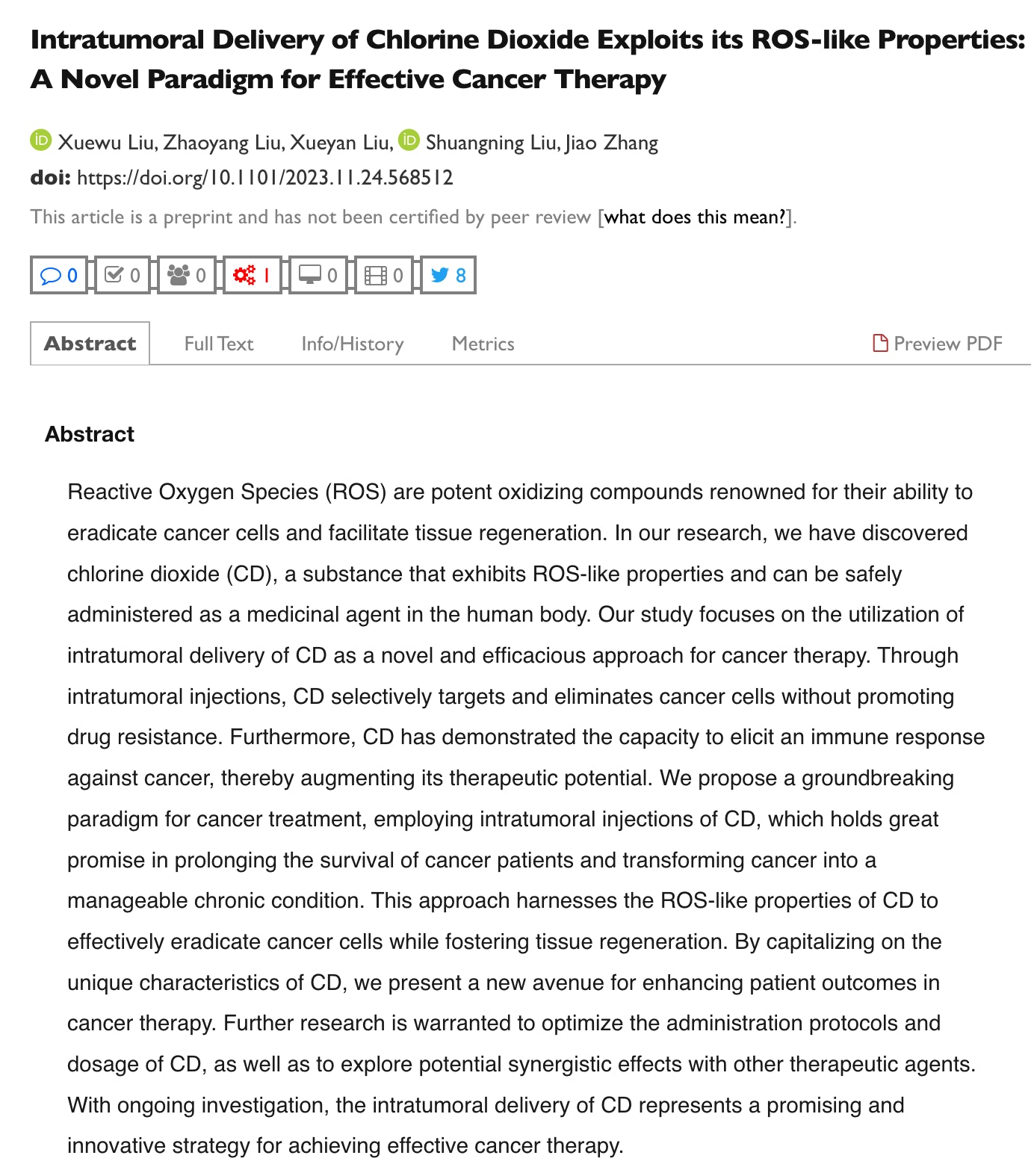
Informe de investigación preclínica sobre la inyección intratumoral de dióxido de cloro
El primer informe de investigación preclínica del mundo sobre el uso de dióxido de cloro para tratar el cáncer.
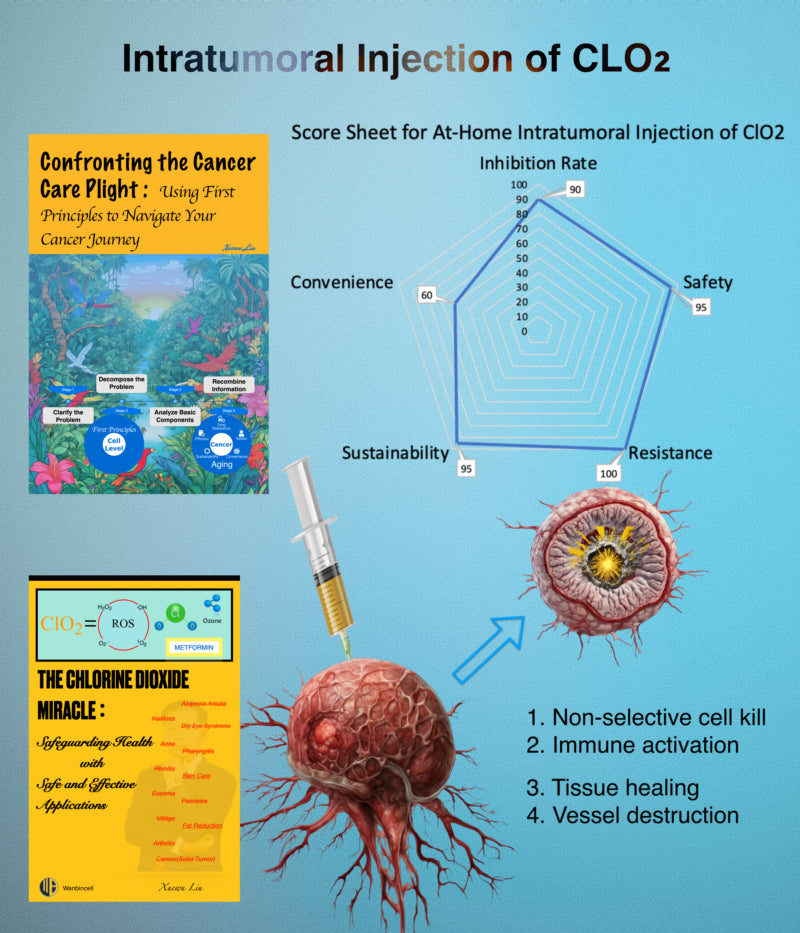
Los fundamentos de este curso
Basada en "El milagro del dióxido de cloro" y "Confrontando la difícil situación de la atención del cáncer", la inyección intratumoral de dióxido de cloro surge como un tratamiento líder para pacientes selectos con cáncer con opciones limitadas. Este método, que aborda la tasa de inhibición, la seguridad, la resistencia, la sostenibilidad y la conveniencia, ofrece un enfoque transformador hacia el cáncer, convirtiéndolo en una condición crónica manejable, sin preocupaciones de mortalidad.



